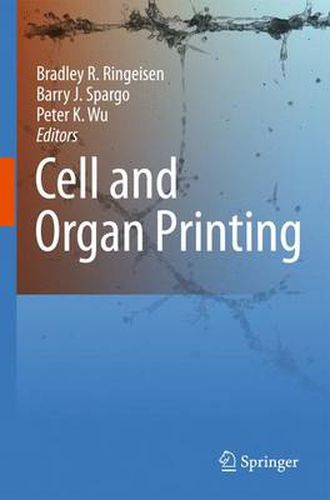Readings Newsletter
Become a Readings Member to make your shopping experience even easier.
Sign in or sign up for free!
You’re not far away from qualifying for FREE standard shipping within Australia
You’ve qualified for FREE standard shipping within Australia
The cart is loading…






This title is printed to order. This book may have been self-published. If so, we cannot guarantee the quality of the content. In the main most books will have gone through the editing process however some may not. We therefore suggest that you be aware of this before ordering this book. If in doubt check either the author or publisher’s details as we are unable to accept any returns unless they are faulty. Please contact us if you have any questions.
Cell and organ printing has become a hot topic of scientific pursuit. Since several early publications between 2000-2003 that demonstrated proof-of-concept, cell and organ printing has blossomed into a rich area for scientific exploration that is being performed by researchers across the globe. Research has thoroughly demonstrated that living cells can be printed via a number of actuations including electrospray, extrusion via micropens and ejection through photothermal, thermal or optical mechanisms. This topic has come of age and it is ripe for exploring the underpinnings of the research to date. We have included research that uses printing technology to deposit or guide cells for tissue engineering applications and for completeness, we have also included chapters describing bacteria printing, biomolecular printing that could be used to build growth factors or recruitment macromolecules into scaffolds, tissue microdissection, as well as live cell printing. The breadth of approaches includes 3D freeform fabrication, ink jet, laser guidance and modified laser direct write techniques. We hope that this book is not the final word but the first word, defining how these tools have been used to take the first steps towards the ultimate goal of creating heterogeneous tissue constructs. Only time will tell whether cell printers will truly become organ printers, but the technologies described in this book hold promise to achieve what the field of regenerative medicine requires - functional 3D scaffolds with multiple cell types differentiated into functional tissue!
$9.00 standard shipping within Australia
FREE standard shipping within Australia for orders over $100.00
Express & International shipping calculated at checkout
This title is printed to order. This book may have been self-published. If so, we cannot guarantee the quality of the content. In the main most books will have gone through the editing process however some may not. We therefore suggest that you be aware of this before ordering this book. If in doubt check either the author or publisher’s details as we are unable to accept any returns unless they are faulty. Please contact us if you have any questions.
Cell and organ printing has become a hot topic of scientific pursuit. Since several early publications between 2000-2003 that demonstrated proof-of-concept, cell and organ printing has blossomed into a rich area for scientific exploration that is being performed by researchers across the globe. Research has thoroughly demonstrated that living cells can be printed via a number of actuations including electrospray, extrusion via micropens and ejection through photothermal, thermal or optical mechanisms. This topic has come of age and it is ripe for exploring the underpinnings of the research to date. We have included research that uses printing technology to deposit or guide cells for tissue engineering applications and for completeness, we have also included chapters describing bacteria printing, biomolecular printing that could be used to build growth factors or recruitment macromolecules into scaffolds, tissue microdissection, as well as live cell printing. The breadth of approaches includes 3D freeform fabrication, ink jet, laser guidance and modified laser direct write techniques. We hope that this book is not the final word but the first word, defining how these tools have been used to take the first steps towards the ultimate goal of creating heterogeneous tissue constructs. Only time will tell whether cell printers will truly become organ printers, but the technologies described in this book hold promise to achieve what the field of regenerative medicine requires - functional 3D scaffolds with multiple cell types differentiated into functional tissue!